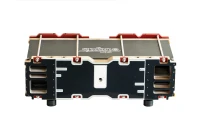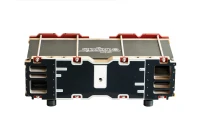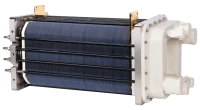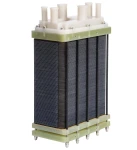- What is a Solid Oxide Fuel Cell (SOFC)?
- Why is it important in the hydrogen and fuel cell industry?
- What are the main features of a Solid Oxide Fuel Cell (SOFC)?
- What specifications should buyers look for?
- How do Solid Oxide Fuel Cells Work?
- What are the core components involved in its operation?
- What are the different types of Solid Oxide Fuel Cells available?
- What are the advantages and disadvantages of each type?
- What are the typical applications for Solid Oxide Fuel Cells in the hydrogen and fuel cell industry?
- How do you measure the performance of Solid Oxide Fuel Cells?
- What factors affect efficiency and reliability?
- What safety standards and certifications should Solid Oxide Fuel Cells meet?
- What are the latest trends and innovations regarding Solid Oxide Fuel Cells?
- What should buyers consider when choosing Solid Oxide Fuel Cells?
- What common mistakes should be avoided?
Browse all solid oxide fuel cells from leading suppliers on our marketplace!
What is a Solid Oxide Fuel Cell (SOFC)?
Fuel cells are electrochemical devices that convert chemical energy in fuels into electrical energy directly, promising power generation with high efficiency and low environmental impact. Fuel cells bear a significant resemblance to electrolysers. Solid oxide fuel cells (SOFCs) are promising clean and efficient power generation devices. Unlike low-temperature fuel cells, SOFCs could run on various alternative fuels such as H2, CO, CH4, CO2 & H2O. Solid oxide fuel cells (SOFCs) have an electrolyte that is a solid, nonporous metal oxide, usually Y2O3-stabilized ZrO2. The cell operates at 600-1000 °C where ionic conduction by oxygen ions takes place. There is no liquid electrolyte with its attendant material corrosion or electrolyte management problems. The solid electrolyte also allows precise engineering of the three-phase boundary and avoids electrolyte movement or flooding in the electrodes. The high operating temperature allows the use of most of the waste heat for cogeneration or in bottoming cycles.
Why is it important in the hydrogen and fuel cell industry?
Hydrogen can be produced from diverse domestic resources with the potential for near-zero greenhouse gas emissions. Fuel cells are remarkable for their versatility, capable of powering applications ranging from large-scale utility power stations to small devices like laptop computers. Hydrogen fuel cells are highly efficient, and reliable, and minimize energy waste. A hydrogen atom is composed of just one proton and one electron, with no neutrons in its nucleus. To generate electricity, the proton and electron must be separated, a process that a fuel cell can accomplish. As a decarbonized fuel, hydrogen produces no carbon dioxide or other harmful pollutants. When hydrogen is used as the fuel, the only byproducts are electricity, water, and heat.
In the hydrogen and fuel cell industry, Solid Oxide Fuel Cells (SOFCs) are crucial because they can efficiently generate electricity directly from hydrogen, producing only water vapour as a byproduct, making them a key technology for clean, sustainable power generation with minimal emissions, especially when paired with renewable hydrogen sources, their ability to operate on various fuels like natural gas, with the potential to transition fully to hydrogen as infrastructure develops, makes them a valuable component in the transition towards a decarbonized energy system. It holds promise for growth in both the stationary and transportation energy sectors. Moreover, their high operating temperatures allow for the co-generation of electricity and heat & can also achieve two to three times the efficiency of conventional combustion technologies further improving overall energy efficiency.
What are the main features of a Solid Oxide Fuel Cell (SOFC)?
- High energy-conversion efficiency
- Long term stability
- Fuel Flexibility
- Low emission
- Environmental safety
- Produce high-purity hydrogen from steam
- Relatively low cost
- Possibility to recover exhaust heat
What specifications should buyers look for?
- Operating Temperature: Typically, between 600-800°C. Lower temperatures reduce material stress and extend the lifespan.
- Power Output: Ranges from a few kilowatts (kW) for residential use to megawatts (MW) for industrial applications.
- Efficiency Rate: Look for higher efficiency rates, especially in CHP applications.
- Modularity: Can add the fuel cells more to overall system as you need.
- Fuel Compatibility: Ensure the SOFC is compatible with the intended fuel type.
- Durability & Lifespan: Check the expected operational hours and maintenance intervals & should have a long lifetime of 40,000-80,000 hrs.
- Cost Consideration: Initial & operational cost are main factors, include the total cost of Ownership, installation, maintenance & fuel cost.
- Certification: CE
How do Solid Oxide Fuel Cells Work?
- Fuel Introduction: The process begins with the introduction of a fuel, such as hydrogen, natural gas, or syngas, to the anode side of the fuel cell. The anode serves as the site where the fuel reacts with oxygen ions to produce electricity.
- Oxygen Ion Conduction: On the cathode side of the cell, oxygen from the air is reduced (gains electrons) and becomes oxygen ions (O²⁻). These oxygen ions then migrate through the solid oxide electrolyte toward the anode. The electrolyte in an SOFC is typically made of a ceramic material like yttria-stabilized zirconia (YSZ), which allows these oxygen ions to move while preventing electrons from passing through.
- Electrochemical Reaction at the Anode: At the anode, the fuel reacts with the oxygen ions that have traveled through the electrolyte. For hydrogen as a fuel, the reaction can be summarized as follows:
H2+O2−→H2O+2e−
This reaction produces water as a byproduct, releases electrons, and generates heat.
For hydrocarbon fuels (like natural gas), the reaction is more complex and produces carbon dioxide and water as byproducts:
CH4+4O2−→CO2+2H2O+8e−
- Electron Flow and Electricity Generation: The electrons produced at the anode cannot pass through the electrolyte and are instead forced to travel through an external circuit, creating an electric current. This flow of electrons through the external circuit is what generates usable electricity.
- Exhaust Gases and Heat: The byproducts of the electrochemical reactions, such as water vapor (from hydrogen fuel) or water vapor and carbon dioxide (from hydrocarbon fuels), are expelled from the anode side as exhaust gases. Additionally, the high operating temperature of the SOFC generates significant heat, which can be harnessed for co-generation applications, improving overall system efficiency.
- System Integration and Stack Configuration: To produce a practical amount of power, multiple SOFCs are connected in series or parallel to form a stack. Each cell in the stack contributes to the total voltage or current, depending on the configuration, allowing the system to scale up for different power requirements.
- Thermal Management and System Efficiency: SOFC systems often incorporate thermal management strategies to utilize the heat generated during operation. This heat can be used in combined heat and power (CHP) systems to provide heating for buildings or industrial processes, significantly enhancing the overall efficiency of the energy conversion process.
What are the core components involved in its operation?
The major components of an individual SOFC cell include the electrolyte, the cathode, and the anode. Fuel cell stacks contain an electrical interconnect, which links individual cells together in series or parallel.
- Electrolyte: The electrolyte is a dense layer of ceramic that conducts oxygen ions. Its electronic conductivity must be kept as low as possible to prevent losses from leakage currents. Popular electrolyte materials include yttria stabilized zirconia (YSZ), scandia stabilized zirconia (ScSZ)) and Gadolinium doped ceria (GDC). The electrolyte material has crucial influence on the cell performances).
- Anode: The anode material for SOFC is the composite of nickel and YSZ particles could provide a stable and highly active anode. The ceramic anode layer must be very porous to allow the fuel to flow towards the electrolyte. The anode is commonly the thickest and strongest layer in each individual cell, because it has the smallest polarization losses, and is often the layer that provides the mechanical support. Anode’s job is to use the oxygen ions that diffuse through the electrolyte to oxidize the hydrogen fuel. The oxidation reaction between the oxygen ions and the hydrogen produces heat as well as water and electricity.
- Cathode: The cathode, or air electrode, is a thin, porous layer on the electrolyte where oxygen reduction takes place. Cathode materials must be, at minimum, electronically conductive. Currently, lanthanum strontium manganite (LSM) is the cathode material of choice for commercial use because of its compatibility with doped zirconia electrolytes. Unfortunately, LSM is a poor ionic conductor, and so the electrochemically active reaction is limited to the triple phase boundary (TPB). To increase the reaction zone beyond the TPB, a potential cathode material must be able to conduct both electrons and oxygen ions. Composite cathodes consisting of LSM YSZ have been used to increase this triple phase boundary length. Perovskite is used for IT-SOFC as they are more active and can make up for the increase in the activation energy of reaction.
- Interconnects: The interconnect can be either a metallic or ceramic layer that sits between each individual cell. Its purpose is to connect each cell in series, so that the electricity each cell generates can be combined. Because the interconnect is exposed to both the oxidizing and reducing side of the cell at high temperatures, it must be extremely stable. For this reason, ceramics have been more successful in the long term than metals as interconnect materials, the ceramics have demonstrated thermal stability at high temperatures and excellent electrical conductivity.
What are the different types of Solid Oxide Fuel Cells available?
Three major configurations for stacking the cells together to increase the voltage and power are
- Tubular: It consists of a tubular support tube, which covers with cathode, electrolyte, anode, and interconnection.
- Seal-less Tubular: The oxidant is introduced through the centre of the support tube, whereas the fuel flows at the outside of this support tube.
- Segmented Cells: Similar to seal-less tubular design, in this fuel is introduced through the centre of the support tube, while the oxidant flows at the outside of the support tube.
- Flat Plate or Planar: The flat multilayer ceramic plate composing of anode, electrolyte, and cathode is used in this design. This flat multilayer ceramic plate is covered with interconnect plates, which have small gas flow channels for fuel and the oxidant.
- Monolithic: This SOFC design is like shell-and-tube heat exchanger design, as it utilizes thin cell components including anode, electrolyte, cathode, and interconnection into a compact corrugated structure. It has 2 different configurations Gas Co-flow & Gas Crossflow
What are the advantages and disadvantages of each type?
Tubular SOFCs:
- Advantages: The elimination of the gas-tight seal problem.
- Disadvantages: The cell internal resistance and the gas diffusion limitation.
Planar SOFCs:
- Advantages: Higher performance level than Tubular SOFC, Easier fabrication &low cost
- Disadvantages: Unstable Sealing, poor thermal cycling stability & relatively high production cost.
Monolithic:
- Advantages: The design is compact cells, self-supporting corrugated structures, and thin cell components.
- Disadvantages: Any difference in the thermal expansion coefficients can result in cell cracking.
What are the typical applications for Solid Oxide Fuel Cells in the hydrogen and fuel cell industry?
- Combined Heat and Power with SOFC: Solids oxide fuel cells are operated at elevated temperatures typically between 750-1000ᵒC which leads to the production of high temperature heat as by product in addition to electrical power. The useful heat from the SOFC is usually utilized in energy requiring units, i.e., preheaters and reformers, to preheat cooling streams or to generate steam and hot water.
- Trigeneration with SOFC: Trigeneration, defined as combined cooling, heating, and power (CCHP), is currently a promising technology for efficient and clean energy production. It uses in the best possible way the chemical energy of the fuel used to generate electricity and heat from the exhaust. Simultaneously, cooling can be generated from absorption or desiccant cooling, consequently reducing the use of electricity in a traditional air conditioning unit.
- Combined Gas Turbine (GT) Power System with SOFC: An integrated fuel cell–GT hybrid system has a higher energy conversion efficiency, low environmental pollution, and possible use of renewable energy sources as fuel. There are two different ways for gas turbines to relate to SOFCs, by indirect or direct integration.
- Power Generation Systems: SOFC technology has been developed for a broad spectrum of power generation applications. SOFC systems that have been considered ranges from portable devices (e.g., 500-W battery chargers), small power systems (e.g.,5-kW residential power or automobile auxiliary power units) to distributed generation power plants (e.g., 100–500kW systems). SOFCs can also be integrated with a gas turbine to form large (several hundred kW to multi-MW) pressurized hybrid systems.
How do you measure the performance of Solid Oxide Fuel Cells?
- Electrical Efficiency: The ratio of electrical output to the energy input from the fuel.
- Thermal Efficiency: In CHP applications, the efficiency that includes the useful heat output.
- Degradation Rate: The rate at which the performance of the SOFC degrades over time, typically measured in millivolts per 1000 hours.
- Ignoring Operating Conditions: High operating temperatures can lead to better efficiency but also require careful consideration of material choices and system design to prevent degradation.
- Failing to Assess Durability: Lifespan and degradation rates should be parameters of focus during the evaluation process.
- Compromising on Safety Standards: is a critical mistake Failure to do so can lead to legal issues and potentially hazardous situations during operation.
What factors affect efficiency and reliability?
- Material Selection: The materials used for the anode, cathode, electrolyte, and interconnects significantly impact both the efficiency and reliability of SOFCs.
- Operating Conditions: It operate effectively under high temperatures, typically between 600°C and 1000°C, which enhances ionic conductivity but can also lead to mechanical instability and thermal cycling issues.
- Thermal Cycling: The effects of thermal cycling, associated with heating and cooling phases during operation, can lead to substantial mechanical stress and degradation in SOFC components.
- Fuel Quality: The quality of the fuel supplied to the SOFC can significantly affect its efficiency and reliability. Impurities such as sulfur compounds can poison catalysts, leading to reduced operational effectiveness, the lower-quality fuels contribute to higher operational costs and increased maintenance challenges.
- Design Configuration: Various stack designs, including planar and tubular configurations, have unique advantages and challenges that affect overall performance.
- Mechanical Properties: The mechanical properties of SOFC components, including their thermal shock resistance and ability to withstand operational stresses, are critical for maintaining reliability
What safety standards and certifications should Solid Oxide Fuel Cells meet?
- ISO 9001: Quality management standards.
- ISO 14001: Environmental management standards.
- IEC 62282: International standards for fuel cell technologies.
- ISO 26142: Hydrogen detection apparatus.
- UL Certification: Safety certification for components and systems.
- ISO 15649: Petroleum & Natural Gas Industries Piping.
- ASME B31.12: Hydrogen Piping & Pipelines Code.
- NFPA 2: Hydrogen Technologies Code.
- NFPA 853: Standard for the Installation of Stationary Fuel Cell Power Systems
What are the latest trends and innovations regarding Solid Oxide Fuel Cells?
- Lower Operating Temperatures: Research is focusing on reducing the operating temperature to extend lifespan and reduce costs.
- Fuel Flexibility Enhancements: Development of SOFCs that can efficiently run on a broader range of fuels, including renewable options.
- Integration with Renewable Energy Sources: Innovations in hybrid systems combining SOFCs with renewable energy for enhanced efficiency and sustainability.
- Modular Designs: Advances in modular SOFC systems allow for easier scaling and integration into different applications.
What should buyers consider when choosing Solid Oxide Fuel Cells?
- Application Requirements: Understand the specific power and heat needs of your application.
- Fuel Availability: Ensure the SOFC is compatible with the available fuel types.
- Maintenance Needs: Consider the operational and maintenance costs over the lifespan of the SOFC.
- Initial Cost vs. Long-term Efficiency: Weigh the upfront costs against the potential savings from high efficiency and low emissions.
- Heat Management: It operates at high temperatures, so ensure you have a reliable method for managing and dissipating heat.
- Monitoring and Control: Ensure the SOFC system includes or supports adequate monitoring and control systems for optimal operation and troubleshooting.
What common mistakes should be avoided?
- Ignoring Fuel Quality: Using poor-quality fuel can lead to rapid degradation.
- Overlooking Safety Features: Ensure all necessary safety features and certifications are in place.
- Focusing Solely on Cost: While price is important, consider the long-term benefits of efficiency, durability, and lower emissions.
- Not Considering Heat Management: SOFCs operate at high temperatures, and managing the heat they produce is crucial for system efficiency and longevity.
- Neglecting Regulatory and Safety Compliance: Ensure the SOFC system complies with relevant regulations and safety standards in your region.
- Underestimating Maintenance Needs: SOFCs can require specialized maintenance. Understand the maintenance requirements and ensure you have access to the necessary expertise & spare parts.
- Ignoring Scalability: If you anticipate future expansion or changes in energy needs, choose a system that can scale up or be modified accordingly.











